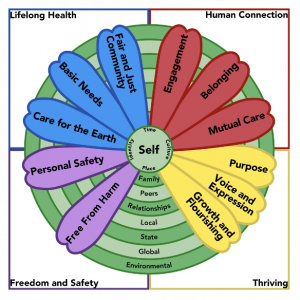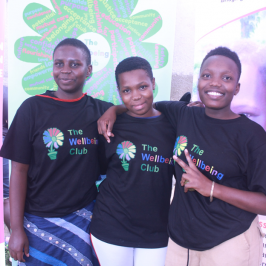December 2021
 By Rebecca S. Levine, Zaharah Namanda, Amy V. Bintliff & Anita Raj
By Rebecca S. Levine, Zaharah Namanda, Amy V. Bintliff & Anita Raj
Background
Depression and anxiety among children and adolescents has been increasing steadily for more than 20 years1, and evidence shows that the COVID-19 pandemic has exacerbated this trend worldwide, particularly for adolescent girls2. Many youth are experiencing severe pandemic-related trauma, including financial and food insecurity3, sickness and death of loved ones4, and increased domestic violence5. Meanwhile, supports that might typically buffer youth against hardship, such as the school structure, social services, extracurricular activities, and time with friends, have drastically changed or disappeared6. Without social connection, youth are isolated and lonely7 during a time when peers typically play a critical role in healthy identity and social-emotional development8.
The Wellbeing Club
Despite the challenges associated with COVID-19, there are remarkable examples of youth empowerment9 as youth take action to make positive change in their communities. This past year, our partnership between UC San Diego and Africa Education & Leadership Initiative (Africa ELI), a Ugandan non-governmental organization dedicated to the education, health, and wellbeing of youth, implemented The Wellbeing Club with 25 youth in Uganda. The Wellbeing Club builds upon the evidence-based Gender, Wellbeing, and Ecological Common Framework10. Through regular leadership meetings, we worked together to adapt the curriculum to meet the cultural and contextual needs of the facilitators and participating youth11, 12, 13.
Curriculum. The Ugandan youth in The Wellbeing Club pilot, majority girls, attended two multi-day retreats, one in February 2021 and one in September 2021, to participate in the curriculum, facilitated by Africa ELI leadership and local college mentors. Youth learned about a multi-dimensional framework of wellbeing through art projects, hands-on activities, and talking circles14.
These conversations helped youth identify the many influences on their day-to-day wellbeing, while simultaneously developing trust and connection as a group. Importantly, youth realized that they were not alone–many of their experiences were shared by their peers–and that others listen and care. These collective conversations also contributed to an increase in critical consciousness, as youth recognized inequalities and oppressions, as well as sources of strength, on multiple levels.
These conversations led into the culminating project. Facilitators created the space for youth to identify a community need, set goals for an activism project, generate a plan, and carry out an activism project that was important to them in their community.
Youth Activism through Wellbeing Clubs. For their activism project, youth in The Wellbeing Club decided to address a pressing issue related to gender inequality in their community: the association between school dropout and teen pregnancy. During the lockdowns of COVID-19, youth noticed the increasing numbers of Ugandan adolescent girls who were dropping out of school, “selling their bodies” to earn a living, and becoming pregnant. For their project, the youth prepared skits to raise awareness about this issue in their community. Survey and interview findings with the youth and facilitators suggest that youth improved in their self-confidence, their ability to use their voice and expression, and their engagement: key constructs that contribute to empowerment.
What have we learned?
Youth value and effectively use spaces to connect with peers in a meaningful way. As youth begin to connect, it is important that opportunities are available for safe, supportive, and genuine connection. Ground rules and conversation structures contribute to social-emotional safety, while conversation starters related to youth’s lived experiences can open the door for peer-to-peer sharing and validation. When adults are part of these conversations, they can provide additional support and resources.
Youth have the power to organize and effect change in their communities. We found that youth were highly aware of and concerned about issues related to their community’s wellbeing. Find out what issues youth care about within your community; or, if they are unaware or indecisive, design opportunities for them to encounter community organizations and activists so they can see what others are working on. This often spurs ideas.
Community-based research-practice partnerships can work with youth-led program models to create change. Throughout our partnership, UC San Diego and Africa ELI collaboratively developed the project with the goal of supporting Ugandan youth empowerment at the forefront. Universities and other research institutions can similarly partner with community-based organizations to develop and evaluate youth-focused programming that fits unique contextual needs.
What’s next?
We are currently synthesizing feedback from our pilot to finalize The Wellbeing Club curriculum. When complete, the curriculum will be freely available via the UNESCO Chair on Gender, Wellbeing, and a Culture of Peace. Meanwhile, Africa ELI plans to roll-out training on Wellbeing Clubs to Ugandan teachers and will host 18 additional clubs over the next three to five years.
Moving forward, we must prioritize local and global solutions that support youth mental health. We recommend a focus on youth empowerment and connection to remind youth that they are important, capable, and loved, and that they can make a difference.

Acknowledgements:
The Changemaker Faculty Fellowship
The Friends of the International Center Fellowship
Africa ELI partners/facilitators: Patrick Bacokorana Kanyeihamba, Norah Nalutaaya, and Dr. Beinomugisha Peninah
About the author:
Rebecca S. Levine, LICSW is a PhD student in Education Studies at the University of California, San Diego. A licensed social worker in the state of Massachusetts, she has worked with youth in clinical, school-based, and academic research settings. Her research centers youth well-being, with specific interests in trauma-informed approaches and community-engaged research.
References:
1CDC. (2021). Children’s Mental Health. Retrieved from https://www.cdc.gov/childrensmentalhealth/data.html.
2Benton, T. D., Boyd, R. C., & Njoroge, W. F. M. (2021). Addressing the global crisis of child and adolescent mental health. JAMA Pediatrics, 175(11), 1108-1110.
3OCED. (2021). Young people’s concerns during COVID-19: Results from risks that matter 2020. OECD Policy Responses to Coronavirus (COVID-19). Retrieved from oecd.org.
4Absher, L., Maze, J., and Brymer, M. (2021). The traumatic impact of COVID-19 on children and families: Current perspectives from the NCTSN. Los Angeles, CA, and Durham, NC: National Center for Child Traumatic Stress.
5CALVEX-UCSD. (2021). Survey: Violence increased in California during COVID-19. Center on Gender Equity and Health.
6Hussong, A. M., Benner, A. D., Erdem, G., Lansford, J. E., Makila, L. M., & Petrie, R. C. (2021). Adolescence amid a pandemic: Short- and long-term implications. Journal of Research on Adolescence, 31(3), 820–835.
7Sabato, H., Abraham, Y., & Kogut, T. (2021). Too lonely to help: Early adolescents’ social connections and willingness to help during COVID-19 lockdown. Journal of Research on Adolescence, 31(3), 764–779.
8Erikson, E. H. (1968). Identity: Youth and Crisis. Norton & Co.
9UNICEF. (2021). Youth and COVID-19: Stories of creativity and resilience. UNICEF South Asia. Retrieved from unicef.org
10Bintliff, A. V. (2020). Multidimensional aspects of adolescent well-being. Psychology Today.
11International Federation for Human Rights. (2012). Women’s rights in Uganda: Gaps between policy and practice. Retrieved from https://www.fidh.org/IMG/pdf/uganda582afinal.pdf
12Plan-UK. (n.d.) The impacts of COVID-19 on girls in crisis. Plan International.
13Ojulu, E. (2021). Pandemic leads to surge of child mothers in Uganda. New African Magazine.
14Living Justice Press. (n.d.) What do we mean by “Circle?” Retrieved from https://livingjusticepress.org/what-do-we-mean-by-circle/
